Lizards & Spiders & Targums, Oh My! [UPDATED]
It’s true-- check it out. Every major translation other than the KJV and NKJV contains lizard instead of spider:
Proverbs 30:28 |
|
| KJV | The spider taketh hold with her hands, and is in kings’ palaces. |
| NKJV | The spider* skillfully grasps with its hands, *Or lizard |
| RV/ASV | The lizard taketh hold with her hands, Yet is she in kings’ palaces. |
| RSV/ESV | the lizard you can take in your hands, yet it is in kings’ palaces. |
| NASB | The lizard you may grasp with the hands, Yet it is in kings’ palaces. |
| NIV/TNIV | a lizard can be caught with the hand, yet it is found in kings’ palaces. |
| JPS | You can catch the lizard in your hand, Yet it is found in royal palaces. |
| NRSV | the lizard* can be grasped in the hand, *Or spider |
| NLT | Lizards—they are easy to catch, but they are found even in kings’ palaces. |
| HCSB | a lizard* can be caught in your hands, *Or spider |
| NET | a lizard you can catch with the hand, but it gets into the palaces of the king. |
| NETS | and the lizard, though dependent on its hands and being easily caught, it lives in the king’s fortresses. |
So, of course I turned to Accordance. I opened up both the NASB and BHS Hebrew Bible modules side by side because I knew that I didn't know the Hebrew word for spider/lizard off the top of my head and the NASB has Hebrew tagging. After determining שׂממית/semamit was the word in question, I triple clicked on it to open the Hebrew and Aramaic Lexicon of the Old Testament (HALOT).

To double-check, I switched over to Brown-Drivers-Briggs Hebrew lexicon. It's still a lizard of some kind. Definitely not a spider.
So where in the world did the King James translators get "spider"?
I've come to the point in the last couple of years that when I want a quick answer to questions like that, I simply turn first to the NET Bible notes. Sure, commentaries are great for more in depth information, but the NET Bible notes have the answer in a nutshell--usually. I mean, normally there's an answer for everything in those 60K+ notes.
Sure enough, the NET Bible seemed to have it covered:
"The KJV, agreeing with Tg. Prov 30:28, translated this term as ‘spider.’ But almost all modern English versions and commentators, following the Greek and the Latin versions, have ‘lizard.’”
Okay, so this made a good bit of sense to me. The KJV Old Testament translators had a reputation for being very familiar with Jewish literature. Perhaps even the meaning of שׂממית was in question, and they turned to the Targums for answers.
For the curious, here is Prov 30:28 in the LXX and Latin as referred to in the NET Bible Note:
| LXX | καὶ καλαβώτης χερσὶν ἐρειδόμενος καὶ εὐάλωτος ὢν κατοικεῖ ἐν ὀχυρώμασιν βασιλέως |
| VULGATE | stilio manibus nititur et moratur in aedibus regis |
As expected, both the LXX and the Vulgate refer to a lizard (or a spotted lizard, or a gecko).
Now, I’ve got the Targums in Accordance as well, but I’ve never really used them much. In fact, I discovered in trying to look up Proverbs 30:28 that I didn’t even have the newest release. After installing the updated set of modules, I was able to look up the passage.
There is indeed a different word here, אקמת/’qmt. I couldn’t find the word in either Hebrew Lexicon, and it does not seem to be similar to the Hebrew word for spider (עכביש/‘akkavish). However, if I understand the nature of the Targums correctly, Proverbs was actually copied from the Syriac Peshitta. So, this really isn’t even Hebrew/Aramaic, but rather Syriac. And thus, this is really outside my language skills. Further, I don’t have an English translation of the Targum for Prov 30:28. However, the English gloss in Accordance for אקמת/’qmt is lizard.
Regardless I would be interested in further information. Perhaps Iyov (if you’re back from your travels) or John Hobbins might offer some insight.
UPDATE: As expected, Iyov provided helpful information in the comments:

I would find it a bit remarkable if the KJV used the Targums -- I do not believe they were expert in Aramaic, and Targum to Proverbs is a bit obscure even today.”
So it seems to me--at this point--that it may indeed be the NET Bible notes that are in error. The source for “spider” in the KJV & NKJV seems to be the medieval commentator Rashi, not the Targum on Prov 30:28, which according to the English gloss in Accordance, also uses a word for lizard, not spider.
Plural "You" in John 1:51

My third point, drawn from John 1:47-51, I labeled "Be ready for the unexpected." In my initial study of this passage, I noticed that in the Greek that in v. 51 Jesus shifts from simply addressing Nathaniel to addressing other disciples who were presumably present. Translating a plural you into English can be a bit tricky since we technically don't have a separate word in standard English for the second person plural. A fairly literal translation of this verse would read something like this:
And he said to him, "Truly, truly I say to y'all [ὑμῖν], y'all will see [ὄψεσθε] heaven open...
Of course, I can translate with y'all because I grew up in the south. And I should also mention that the KJV communicates the second person plural (at least clearly in the second instance) because Elizabethan English also allowed for the distinction by using the now archaic ye:
And he saith unto him, Verily, verily, I say unto you, Hereafter ye shall see heaven open (John 1:51 KJV)
Regardless, when there is a shift of person in the Bible such as that in v. 51, I readily admit that it's not always significant. But here I believe it is. Jesus' message of what a disciple would experience was not something meant for Nathaniel alone. A few translations make an effort to represent the second person plural, but most traditionally have not. Originally, I had been planning to use the NLT for this message, not only because I believe it communicated the entire passage well, but especially because it brought out the plural "you" here:
Then he said, “I tell you the truth, you will all see heaven open... (John 1:51 NLT)
However, then on Friday, I received my copy of the NET Readers Bible in the mail. Looking at the passage and especially v. 51, I was pleased to see the second person plural rendered here as well:
He continued, “I tell all of you the solemn truth–you will see heaven opened... (John 1:51 NET)
Thus I began my little "NET for a month" experiment and preached from it on Sunday.
I should point out that a number of other translations mention the plural "you's" in the footnotes, including the ESV, HCSB, NRSV, NIV and TNIV. The REB is another translation that renders the plural in the actual text.
So which is better: text or notes? I would suggest that the better rendering is when it can be done in the text for the sake of those listening without a Bible in front of them.
Feel free to leave your opinion in the comments.
iPhone Bible App Roundup: July 2007
Let me say up front that on the iPhone, there's nothing like the kind of offerings Olive Tree has for other PDA's and smartphones. In fact, I contacted Olive Tree to see if they were working on any kind of solution for the iPhone. They asked me if I would be interested in testing the text files they offer for iPods on my iPhone since no one at Olive Tree actually has an iPhone. I had to inform them that text files cannot be placed on an iPhone in the same manner that one can on an iPod because the free space on the iPhone's flash drive cannot be directly accessed. At this point, I don't know where Olive Tree's strategy stands for the iPhone, if there is one at all.
A major drawback of the iPhone is that Apple will not allow third party applications on the iPhone at this point. Now, I've heard rumors that a software development kit is in the works, but supposedly the Windows version isn't up to speed with the OS X version at the moment, so Apple wants to wait until the SDK's have platform parity before either is released. These days, Apple Inc. (no longer Apple Computer) has quite a few Windows software offerings and actually sells more iPods and iPhones to Windows users than to Mac users. Until the Windows SDK is up to par, we have no third party apps. Again...if this rumor is true at all.
The solution, and one endorsed publicly by Apple, revolves around Web 2.0 apps that can run in the iPhone's stripped down Safari browser. Quite a few "programs" have been released so far and are cataloged at websites such as The iPhone Application List. Some of these applications are quite handy, but in the interest of myself and readers of this blog, I thought I would try to create an ongoing series regarding the Bible offerings for the iPhone as they become available.
Currently, there are three iPhone applications that offer access to the Bible. I will offer brief reviews of them in the order they were released.
iPhone Scriptures/LDS Standard Works (KJV & Mormon)
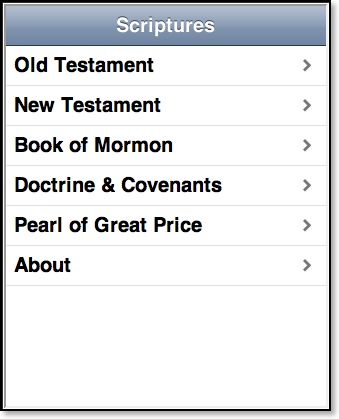
Technically, these are two separate programs, but they use a similar interface, so I'm going to assume there's some connection between them. Released about a week after the launch, iPhone Scriptures was the first Bible related app available for the iPhone. The interface is straightforward. Clicking on a selection such as "New Testament" offers the user a list of New Testament books. Selecting a book takes the reader to another screen with chapter numbers. Selecting a chapter yields the entire text for that chapter:

The button at the top of the text that says "Library" takes the reader back to the initial screen. What seems to be an obvious omission are arrows that would take the reader to the previous or next chapters. No search features are present, but it's promised to be available soon. In case you didn't notice, the biblical text is limited to the King James Version, which is the officially used translation of the Mormon Church. This isn't surprising, but will certainly limit widespread use of this program.
The only functional difference between iPhone Scriptures and LDS Standard Works is the ability to turn off the Mormon Scriptures in the latter program for those who don't want to look at the Mormon-specific titles. This is done in a "Settings" tab at the bottom in place of the "About" tab in iPhone Scriptures.
I saw iPhone Scriptures within a day or two of it's release, and the initial interface had very tiny tabs making it virtually unusable. The current version is much improved.
3onesix Ministry Tools (NIV)
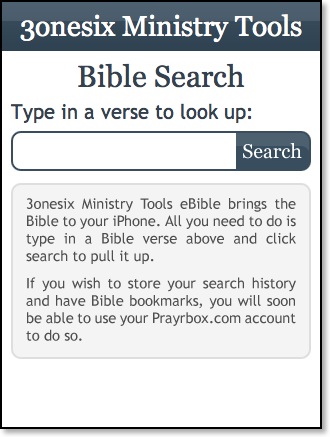
This Bible was released around July 10, and takes a slightly different approach to accessing the Scriptures than the programs mentioned above. In 3onesix Ministry Tools, the user must know what passage he or she wants to view in advance. For instance, typing "Matthew 1" results in that chapter being displayed.
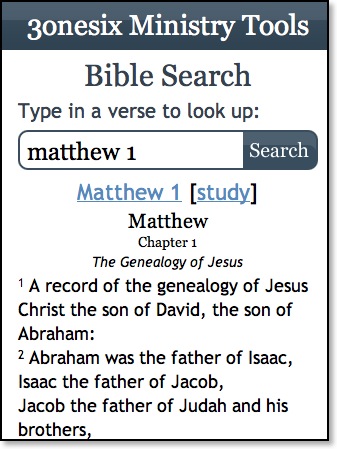
Clicking either of the links on the chapter screen takes the user to the regular eBible website which is what this program is based on. Currently, the only text available from 3onesix is the NIV, but one would hope that others would eventually be made available since eBible offers multiple versions. At the moment, unless the user goes to the eBible site, there is no direct search feature in the app specifically made for the iPhone.
iBibleSpace (ESV)
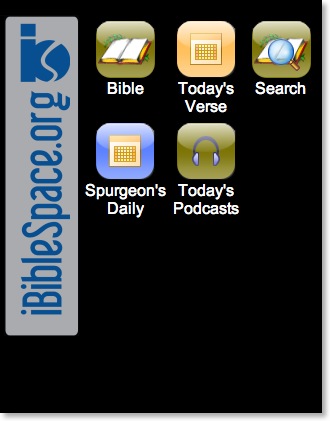
By far the most impressive iPhone Bible app to date is iBibleSpace released a couple of days ago. Anyone who has already spent time on an iPhone will immediately recognize an interface that draws its cues from the regular iPhone home screen. By choosing the first option, "Bible," one is presented with a similar interface as found in the original iPhone Scriptures application mentioned above, but it's designed to look much better in iBibleSpace. Again, the user can select a book of the BIble (OT & NT books are on the same screen), and then a chapter.
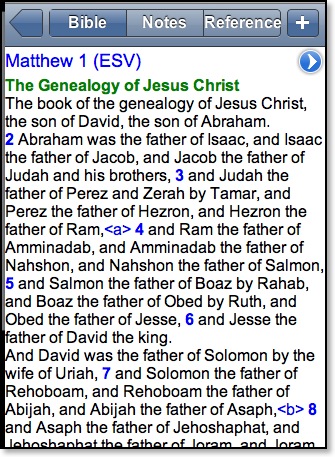
The text as shown above is quite clear, and contrary to the screenshots I took above on my MacBook (I don't know of any way to grab screens on my iPhone), the text such as the word "Reference" above fits perfectly onto it's button on the iPhone.
iBibleSpace has quite a few features going for it that puts it ahead of the other two iPhone Bibles. First of all, the ESV text as shown here includes access to textual footnotes: notice the "" at the end of v. 3. That note designation is actually hyperlinked and will take the user to the bottom of the screen where the footnotes all appear at the end of any chapter. You might also notice the right-pointing arrow that will take the user to--you guessed it--chapter 2 where there are both previous chapter and next chapter buttons.
A number of other options are offered at the top of the screen as well. The large single-colored left pointing arrow will take the user back to a listing of all chapters in the biblical book. The "Notes" button allows the reader to access a personalized account where one can store customized notes. The plus (+) button on the far right allows the user to add a new note and even highlight a verse in one of six different colors [gee, maybe I could transfer all the notes from my wide margin NASB to my iPhone!...or maybe not]. The "Reference" button takes the user to notes from Matthew Henry's Concise Commentary (not of great interest to me, but it's a nifty feature, nonetheless).
The only real downside I saw of the biblical text in iBibleSpace was the dreaded words of Christ in red. If this "feature" could be turned off, I believe that would be helpful to many.
Going back to the IBibleSpace main screen is simple because it always remains as a separate page/tab in the iPhone browser (in case you didn't know, the iPhone will allow the user to have multiple pages open at once, much like tabs in regular browsers). "Today's Verse" is just what you would expect it to be: a daily Bible verse. There is a link to read the entire chapter from which the verse comes in context if one is so inclined.
Another distinguishing feature of iBibleSpace is its search feature:
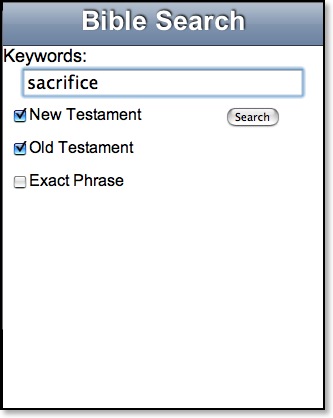
One can search either or both testaments and exact phrases. Results are displayed in groups of five at a time with an option to select "More."
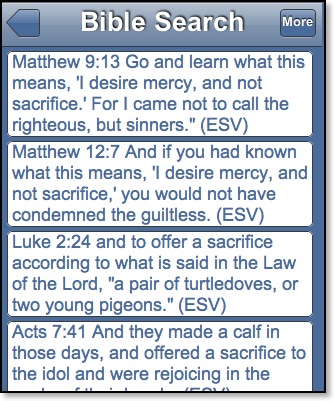
However, I found it odd that NT hits are listed before OT results. I would prefer them my results to be listed in canonical order. Further, in most Bible programs the search word is usually highlighted in some way, but not so in iBibleSpace.
The other two buttons on the home screen will lead the user to daily devotions from Spurgeon or podcasts from a variety of conservative Christian radio shows. The selections are a bit odd in my opinion. I cringed when I saw Joyce Meyer, but I occasionally enjoy listening to Ravi Zacharias' show. The great majority of the offerings, however, I would not have any regular interest in. I also doubt I'd run to my iPhone for a daily devotional from Charles Spurgeon either. In fact, it seems odd to me that it's a primary button on the home screen.
Regarding the podcasts, though, I followed one all the way to the show to see if the iPhone would actually play it. The link was to an MP3 file that launched QuickTime on the iPhone. I think that was the first time that I realized that I even had QuickTime on my iPhone!
iBibleSpace is impressive on many levels: features, design, and consistency of its interface (one never follows a link that leads to a page not formatted to the iPhone unlike the 3onesix app). Even though the ESV is not one of my preferred translations, I put iBibleSpace at the top of my iPhone app bookmarks. At the present time, iBibleSpace is far and away the best Bible app available for the iPhone.
I'd still like to see original language texts on the iPhone, although I have no idea if the iPhone would even support Greek and Hebrew fonts. Of course one would presume that it is using Unicode fonts already. Something like the NET Bible would be interesting to have on the iPhone as well, and perhaps because the folks behind the NET have been so Internet savvy, we will see something in the near future. One also wonders if an iPhone interface to something like Bible Gateway couldn't be created to take advantage of multiple translations.
Further, I still am hopeful for third party apps. The major drawback of any of these apps relates to their dependence on the Internet. Even with a WiFi connection, they are not as fast as a native application would be.
In the meantime, three weeks have yielded three distinct Bible apps of varying creativity and features. As others will undoubtedly come available in the weeks ahead, I'll be sure to cover as many as possible here on This Lamp.
Comparing Apples to Pupils: Zechariah 2:8 in the HCSB, NET, and NLT
also all Hebrew below has been transliterated as RapidWeaver seems to continue to have difficulties correctly rendering Unicode Hebrew]
I've stated on a number of occasions how much I respect the HCSB translators' decision to regard accuracy over tradition in many of the translation's renderings. In my review last year of the HCSB, I remarked that although the HCSB courageously breaks with traditional wording of a favorite verse like John 3:16, it does so strictly for the sake of better communicating the meaning of that verse which is easily misunderstood in most translations.
And so it is with Zech 2:8 which was part of our Bible study yesterday at church.
Zechariah 2:8 |
|
Traditional Renderings |
Accurate Renderings |
| For thus saith the LORD of hosts; After the glory hath he sent me unto the nations which spoiled you: for he that toucheth you toucheth the apple of his eye. (KJV) | For the LORD of Hosts says this: “He has sent Me for |His| glory against the nations who are plundering you, for anyone who touches you touches the pupil of His eye. (HCSB) |
| For this is what the LORD Almighty says: “After the Glorious One has sent me against the nations that have plundered you—for whoever touches you touches the apple of his eye— (TNIV) | For the LORD who rules over all says to me that for his own glory he has sent me to the nations that plundered you–for anyone who touches you touches the pupil of his eye. (NET) |

Using Accordance, I scanned the KJV to determine that this translation uses the English word apple for four separate Hebrew words in the OT:
- ’ishwon: Deut 32:10; Ps 17:8; Prov 7:2
- tappuach: Song 2:3; 8:5; Joel 1:12
- vat: Lam 2:18
- vava: Zech 2:8
If anything, "apple of his eye" seems to communicate something slightly different in our culture than what was intended in the text. I did a quick survey of my class yesterday as to the meaning of "apple of his/my eye" and most responses were of the "cutesy" variety, often noting the idea of a daughter being the apple of her father's eye.
In Zech 2:8, vava literally means "gate" of the eye; but ultimately, that's too literal for understanding in English. The meaning here is essentially the pupil as the HCSB and NET correctly translate it. McComiskey notes:
In this analogy, the eye is Yahweh's [...] As the eye is extremely sensitive to touch, so God is sensitive to what threatens his people. The statement develops further the important postexilic theme that God will protect his people and allow no hostile intervention. (The Minor Prophets, vol. 3, p. 1061)
In other words, to mess with God's people is like poking a stick in God's eye, so watch out!
One more note: the NLTse translation of Zech 2:8 bypasses the apple/pupil issue to focus on the meaning of the phrase:
After a period of glory, the LORD of Heaven’s Armies sent me against the nations who plundered you. For he said, “Anyone who harms you harms my most precious possession.
But more important than that, of all the most recent translations, only the NLT attempts to correct the tiqqune soferim found in this verse. That is, the ancient Hebrew scribes were offended at the idea of poking a stick in God's eye, so the wording was changed from "my eye" to "his eye." Thus, in the end, according to one's opinion and evaluation of the dynamic rendering "my most precious possession," the NLT may turn out to be the most accurate translation of Zech 2:8 of those surveyed here.
For another look at a tiqqune soferim, see my post on Hab 1:12.
Top Ten Bible Versions: The Honorable Mentions
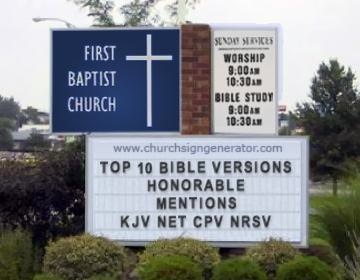
In hindsight, I don't know if the "Top Ten" designation was all that accurate because these aren't the ten Bibles I use the most. But in addition to the first few which I actually do use a good bit, I also wanted to introduce a few other translations that have stood out to me over the past couple of decades since I began collecting them. There are a few other Bibles that were contenders for such a list. I thought that I could briefly mention them in this follow up post.
King James Version.
I would imagine that if most people put together a top ten list, the KJV would be on it. I almost included it, but it seemed too predictable. Plus, I'm in no position to necessarily write anything new on the KJV (not that my other posts were wholly original either). Nevertheless, the KJV does deserve recognition because no other English translation has held the place of prominence that it has in the history of translations. It is still used today as a primary Bible by millions of Christians, still ranks somewhere in the top three positions of sales in CBA rankings, and even for those who have moved onto something newer, it is still the translation that verses have been memorized in like no other version.
I predict this is the last generation in which the KJV will still receive so much attention, but I have no trouble saying I may be wrong. It's difficult to say that one can be reasonably culturally literate--especially when it comes to the standards of American literature--without a familiarity of the KJV. Nevertheless, I cannot in good judgment recommend the KJV as a primary translation for study or proclamation because its use of language is too far removed from current usage. I don't mean that it's entirely unintelligible--not at all. But a primary Bible should communicate clear and understandable English in keeping with the spirit of the Koiné Greek that the New Testament was written in. I also cannot recommend it as a primary Bible because of the manuscript tradition upon which it rests. There's simply too much that has been added to the text. It was certainly the most accurate Bible in its day, but this is no longer true. My exception to this, however, is that I do find the KJV acceptable for public use with audiences made up primarily of senior citizens since this was exclusively their Bible. And the KJV still seems to be appropriate for use in formal ceremonies including churches and weddings--although I have not recently used it for such.
There is some confusion on what is actually the true King James version. Most do not realize that the average KJV picked up at the local book store is not the 1611 edition, but rather a 1769 fifth edition. And the reality is that there are numerous variations of this out there. For those who want a true and unadulterated KJV, the recently released New Cambridge Paragraph Edition seems to be the one worth getting.
The NET Bible.
The NET Bible is one of about four translations (including the ESV, NRSV, and KJV) of which I received the most emails asking why it wasn't included in my top ten. The primary initial reason for the NET Bible's exclusion was simply that I had not spent enough time with it. I made the unfortunate decision to purchase a "2nd beta edition" only a few weeks before the final first edition came out (of which I recently obtained a copy).
Everyone I've heard speak about the NET Bible has high remarks about the 60K+ notes that come with the standard edition. And I can honestly say that these notes have become a regular resource for me when I study a passage. I don't hear as much high praise for the translation itself, though I don't hear anything particularly negative about it either. In general, though, I do recommend the NET Bible. I really like the editions I've seen made available--not just the standard edition, but also the reader's edition, and the Greek/English diglot which I'm very impressed with. The notes in the diglot are a slightly different set than what is in the standard edition. The "ministry first" copyright policy and the ability to download the NET Bible for free from the internet are very commendable on the part of its handlers.
I'd like to see the NET Bible get more attention, and I'd like to see more people introduced to it. I'm not sure it will get the widespread attention it deserves as long as it can only be obtained through Bible.org. In spite of the fact that my top ten series is over, I am going to continue to review translations, and the NET Bible will probably receive my attention next. But we have to spend some quality time together first.
The Cotton Patch Version.
I decided not to include a colloquial translation in my top ten, but if I had, the Cotton Patch Version of the New Testament would have held the category. Most colloquial translations are fun, but a bit gimmicky. The Cotton Patch Version rendered from the Greek by Clarence Jordan was anything but gimmicky. During the height of the Civil Rights Movement in the 1960's, Jordan recast the events of the New Testament in the Southern United States. Replacing Jew and Gentile with "white" and "negro," and status quo Judaism with Southern Baptists (of which he was one), Jordan clearly brought the radical message of the New Testament into current contexts. The Cotton Patch Version is certainly fun reading if you are familiar with Bible Belt southern locales, but more importantly, the message is gripping as well.
The New Revised Standard Version.
The NRSV is an honorable mention I've added since I first announced the series. Originally, I felt like the NASB represented both the Tyndale tradition and formal equivalent translations well enough, plus at the time my use of the NRSV had become quite rare. Then my little NASB vs. NRSV comparison that I wrote with Larry revived my interest in the NRSV, and I now even have a copy sitting on my desk.
A year ago, I would have thought that the NRSV had seen its last day in the Bible version spotlight--except for academic use, but it seems to have had a bit of a renaissance with new attention and even new editions being published. It is still the translation of choice for the larger biblical academic community, primarily in my opinion because it has the widest selection of deutero-canonical books available of any translation. In its early days the NRSV was also embraced by many in the evangelical community but such enthusiasm seems to have waned. I think than rather than fears of theological bias, evangelical readers simply have too many other versions to choose from since the release of the NRSV.
Yes, the NRSV may be a few shades to the left of evangelical translations, but I've spent enough time with it to state clearly that it is not a liberal Bible. Don't let sponsorship from the National Counsel of Churches drive you away. If that were the only factor in its origin, I'd be skeptical, too, but the fact that Bruce Metzger was the editorial head of the translation committee gives me enough confidence to recommend it--if for nothing else, a translation to be read in parallel with others.
Well, is the series done? Not quite yet. I'll come back later this week with a few concluding thoughts about the list and the current state of Bible translations in general.
The Grantham Bible Study Method
A Guest Post by Chuck Grantham
Rick has asked me to expand a bit on how I prepare for Sunday School for those who may not read the comments section.
The first thing I should say is that I do not teach a Sunday School class. I do this primarily for myself. On the other hand, I think any group of believers studying the Bible deserve good answers when they have questions, and the Learner Guide in the Lifeway Explore the Bible series, the Southern Baptist Convention’s Sunday School quarterly, cannot possibly address all the questions that can come up in your average class.
It is also a help to the actual teacher when someone can give a quick answer to those odd, even off-topic questions that come up, so the teacher can get back on topic. You culprits know who you are….
I should also add that this is a new routine for me, and is slowly evolving as I use it. It also varies a bit depending on the genre of the biblical book we are studying. For Old Testament history I do more historical study and less textual work because my Hebrew and my resources aren’t up to it. For the Gospels I do more synoptic comparison and non-canonicals research, because that‘s a scholarly trend right now and I am fascinated by the agrapha, even if Craig Evans dismisses it.
So as they say, this is where I am at right now, in regard to Sunday School preparation. Here are the steps as I can best outline them:
1. Read the lesson passage in the Learner book.
Of course, you’ve got to read the text first. This can involve different amounts of material. The lesson starts off with a title and then two sets of verses:
A) Background passage: the length of material assumed necessary to grasp the context of the lesson.
B) Lesson passages: those verses actually studied and commented upon in the Learner book.
Sometimes the background passage and the lesson passages are the same. Sometimes the background is several chapters and the lesson passages are the highlight verses within the background passage. My strong suspicion is most folk only read the lesson passages, and even that only in the translations provided in the Sunday School book.
Yes, I said translations. The Explore The Bible Learner Guide provides the lesson passages in side by side renderings from the Holman Christian Standard Bible and of course, the King James Version. This selection leads us to my next step.
2. Check HCSB and KJV for obvious differences.
I love parallel Bibles. But they can confuse someone who does not understand the background of translations. Not only do different Bibles read differently because of different translation philosophies (mirroring the original text versus mirroring contemporary speech of the translation‘s day, to grossly simplify) but also because translations are based upon different “original” texts. Speaking strictly of the New Testament, Older Roman Catholic Bibles were based upon the Latin Vulgate, which varied in places from the King James Bible, based upon Erasmus’ Greek New Testament. And both vary again from Bibles published in the last 130 years, when discoveries of massive numbers of Greek, Latin, Coptic, Syriac and many more language new testament manuscripts have led scholars to create several “standard” Greek New Testaments, which has further led to each new translation’s translator(s) being forced to decide in numerous places which Greek wording seems more original to them.
All of which is to say that the HCSB and the KJV do not always agree, and not only because centuries separate the vocabularies of the two. The venerable old KJV is based on Greek manuscripts from the Middle Ages, which tend to be more verbose in fear of leaving something good out. The HCSB is based on the current scholarly Greek New Testament, which tends to follow the earliest well-produced manuscripts, whose scribes had not yet added wordings to make things clearer or more reverent, and thus tends to be shorter.
So, after reading the HCSB and the KJV, I do a comparison of their wording, and I take a pen and circle the differences I see, either in vocabulary or in text. That gives me a series of verses which I can then use as a guide for the next step.
3. Check NET diglot for textual notes.
This is the first step where level of education rears its head. I personally have what might be described as “word study Greek.” I can read Greek letters and I know a lot of root words in the vocabulary. Thus I can use certain tools an English-only reader cannot. There are tools for the Greek-impaired to do these sort of things, too, though.
For those with Greek or without, the NET Bible First Edition is a great help, if you don’t let yourself be intimidated. With over 60,000 notes (compared to many study Bibles’ 20,000 notes) the NET is either a study Bible on steroids or an emaciated commentary. Besides the inevitable complaints about its translation philosophy, the NET’s chief strength is its greatest weakness: it has notes for every level of user. Simple definitions of terms sit alongside lengthy discussions of textual critical issues using manuscript numbers and Greek wording. Transliterations are provided as well as notes with “literal” translations of phrases, though.
My preferred edition of the NET when dealing with the New Testament (and we Christians usually are) is the NET Diglot. That is, a parallel Bible with the Nestle-Aland 27th (NA27) edition of the Greek New Testament combined with the NET English translation and notes. Why? Because I am a hopeless New Testament textual criticism geek. Reading the New Testament in Greek for most will simply confirm how careful most translations are to get things as right as they can. And because inevitably translators use
the same reference books and read each other’s translations, a good parallel English New Testament will reveal strong similarity in most Bible passages. But when they do differ, there is no better one stop resource than the NET diglot, which combines the mini-encyclopedia of the NET with the second mini-encyclopedia of the NA27, which endlessly footnotes even minor variations in the wording of NA27’s Greek text by citing which important manuscripts differ from the NA27, then which ones agree with NA27, then which important previous editions of the Greek New Testament agree or disagree with NA27. All of this together with an appendix citing the approximate age of the important manuscripts and what text of which New Testament books they contain.
All this can make for information overload, and the chief complaint against NA27 is that it requires one to learn practically another language in the form of NA27’s symbols and abbreviations to truly use it well. There are two solutions to this:
a) NET Diglot comes with a little foldout containing the witnesses, signs and abbreviations used in the NA27 that will be constantly in readers’ hand.
b) NET footnotes on the opposite page contain English sentences stating as simply as possible much the same information as abbreviated in the NA27 footnotes.
So, having found out what the NET Diglot says about the differences between HCSB and KJV, I will usually circle or underline the variation in the Learner book, draw a line out to the margin of the page, and write out a transliteration of the Greek, together with the earliest manuscript or two supporting each variation with rough date.
At this point I will also be mulling over other things I have learned from the footnotes on the NET side of the diglot, which I will have noticed mentions literal translations, other text critical issues, or even translation issues. But now it is time to go back to the Learner Guide for the next step.
4. Read the passage overview in lesson book, noting where the author keys on words, provides definitions or parallel verses.
In other words, grill the author on the assertions he makes. If he defines a word, I’ll circle it, find the Greek term in the diglot, see how NET translates it, and if I’m at all suspicious of the English term, walk over to my book case and pull out my copy of The New International Dictionary of New Testament Theology: Abridged Edition
Key words and parallel verses require more work and more tools. I will cross check the English against the Greek so I get one term, then for the key words simply see how often they are repeated in the Greek text. I do this with E-sword, the excellent FREE (mostly) Bible software. By simply highlighting the Greek word and clicking, I can run a search on the word in the current book or the New Testament. With a copy, a switch to the LXX, and a paste, I can further search for the word in the Old Testament. Even with my poor Greek, I can flip through English versions in E-sword and get a sense of the range of meaning for the word, and very often discover parallels to my New Testament text.
If this doesn’t satisfy me (and by now you realize I’m not easily satisfied) I can hit the books again. Specifically Goodrick, Kohlenberger and Swanson’s The Exhaustive Concordance to the Greek New Testament
This is the point scratch paper comes in handy. Among these many verses I will make note of the parallels quoted in the Learner book and my search I find significant. That leads me to the next step.
5. Significant parallels I paste together and print out in Greek and English, particularly where outright quotes from LXX or a usage determining a discussed word meaning occurs.
Simply put, I’ll cross check my scratch list, pick the most important, then make a file of the New Testament and Old Testament parallels in Greek and English which I resize as small as readable, then print up double-sided to be folded up and stuffed in my now bulging Leaner Guide, along with that possible article from NIDNTT.
6. I print out Robertson's Word Pictures in the New Testament
Because I need all the Greek help I can get, and because, to borrow from Rick Brannan, A.T. Robertson was a stud. Or to be more technical, because Robertson wrote a still highly regarded Greek grammar and he published Word Pictures after the papyri boom of the 1900s which changed forever our understanding of New Testament Greek.
7. I read Barclay's Daily Study Bible
Yes, it is only here I get to the commentaries proper. Unless I am cheating a bit. Which lately I am. I bought a copy of Thomas Schreiner’s 1 Peter, 2 Peter, and Jude in the NAC series)
Anyway, by this time I know enough about the lesson passage that I can run through the commentaries pretty quickly. Mostly I am looking for different material: cultural background, classical references, historical information. Besides the cultural, most of this will not likely come up in Sunday School. I make notes on my scratch paper, which is at least two sides of paper or two sheets by now.
8. I run off the appropriate page(s) from Bruce Metzger’s Textual Commentary on the Greek New Testament
Because I’m a textual criticism geek, but also because Metzger sometimes has odd little sidelines and Omanson discusses how segmentation can affect translation. And of course, Metzger is still THE Man.
9. I sit down with all these pages and put short notes in my Learner book.
Basically, I select what I find important, interesting, and/or easy to write briefly and write it up in the book where I will easily remember it. That usually includes Greek transliteration of key words or confusing terms in KJV along with definitions, notations of words not in the Greek supplied for English clarity, parallel verse notations, occasional flow charts of the author’s argument, and almost always questions about multiple interpretations of a phrase or verse. That’s a fair amount of black ink
scribbled in the book, along with that now sizeable sheaf of printouts in the center of the Learner Guide.
10. After a break of a day or two, I go back and review what I've compiled.
Like preparing for a test, I check to see what I remember and what I need to review. I will also likely scratch out some notes and add some new ones, because I see things more clearly after a break.
11. I go to Sunday School and never use ninety percent of what I've learned.
Because I’m not the teacher, and because I want to help my fellow members learn, not confuse them.
12. I come home from Church and after lunch start the process over again for the next week's Sunday School lesson.
Because I really enjoy all this study.
Thanks Chuck for sharing all this. I've heard it said (and I agree) that sincere study of the scriptures is just as valid of a style of worship as any other. I know many of This Lamp readers will relate to Chuck's enthusiasm for understanding the scriptures even if they have slightly different steps of their own. I can relate to Chuck because I've always said that I feel most alive when learning, and I feel most in God's will when I am teaching what I've learned.
Chuck Grantham can be reached at chuckgrantham@cableone.net, and I know he would appreciate your feedback in the comments.
Hebrews 4:8 in the KJV
The Lifeway Explore the Bible curriculum uses two translations as its base, the HCSB and the KJV and normally reproduces the verses side by side. Any quick look at Heb 4:8 in these two translations immediately demonstrates a problem:
| HEBREWS 4:8 | |
|---|---|
HCSB |
KJV |
| For if Joshua had given them rest, He would not have spoken later about another day. | For if Jesus had given them rest, then would he not afterward have spoken of another day. |
Obviously, there's going to be a big difference in the meaning of the passage based on whether the writer is speaking of Joshua or Jesus. What?! You don't remember the Old Testament story about Jesus leading the Israelites into the Promised Land?
For sake of comparison, here are a few other translations of the verse:
"For if Joshua had given them rest, God would not have spoken later about another day." (NIV/TNIV)
"Now if Joshua had succeeded in giving them this rest, God would not have spoken about another day of rest still to come." (NLT)
"For if Joshua had given them rest, He would not have spoken of another day after that." (NASB)
"For if Joshua had given them rest, God would not speak later about another day." (NRSV)
"For if Joshua had given them rest, God* would not have spoken of another day later on." (ESV)
Obviously, the majority consensus is for Joshua, not Jesus. And it certainly makes sense because the context of the writer's argument is an analogy that he's drawing from the Israelite's entrance into the Promised Land. So why the difference in the KJV?
Well, part of the problem with the King James Version is that in the New Testament the translators chose to transliterate the Greek versions of the names of Old Testament characters rather than matching up the spellings with what was used in the KJV Old Testament. So in Matt 24:37, Noah is represented as "Noe," Elijah becomes "Elias" in Matt 11:14, Isaiah becomes "Esaias" in Matt 3:3 and so on. Some of these the reader will catch, but such inconsistency between the testaments can and certainly has created confusion and even misinterpretation in the past. [Consider for example, the blunder made by Mormon "prophet" Joseph Smith in Doctrine & Covenants 76:100, where he writes, "These are they who say they are some of one and some of another—some of Christ and some of John, and some of Moses, and some of Elias, and some of Esaias, and some of Isaiah, and some of Enoch...." It hardly seems fitting for a so-called "prophet" to make such an error that would become part of their sacred and "inspired" writings, wouldn't you think?]
That brings us to Jesus and Joshua. The two have the same name. Jesus is the Greek form (Ἰησοῦς/Iesous) and Joshua is the Hebrew form (יהושע/Yehoshua) of the same name. So, technically, the KJV translators were being consistent in their method of keeping the Greek form of the names of the Old Testament characters when it came to Heb 4:8. But surely anyone can see the confusion that such a practice causes. The same kind of misreading is caused in Acts 7:45 which again reads "Jesus," when the context is obviously referring to Joshua.
Every major modern translation today has gone to keeping the names consistent between the testaments. And the TNIV has gone a step further in that the translators have chosen to update the spellings of certain names to bring them closer to their Hebrew originals. A chart of such spelling changes is in the back of every TNIV Bible.
Hebrews 4:8 is a perfect example of why I never recommend the KJV as a primary translation for serious study. Even the student who can plow through the Elizabethan English fairly well has a strong possibility of misinterpreting a verse like Heb 4:8 or Acts 7:45. Further, I've noted since beginning our study in Hebrews, as I've been translating some of it, that the Greek is more difficult in this book than most other places in the New Testament. And that is reflected in the KJV rendering of many of the passages in Hebrews which come across as nearly unintelligible (see, for instance Heb 3:16-18 in the KJV).
I suppose it would be controversial for some to hear that the KJV can lead to misunderstandings and misinterpretations of the text in a verse like Heb 4:13 or Acts 7:45. Maybe that's why the editors at Lifeway decided to simply leave that verse out of the study. But v. 8 is an essential part of the writer's argument. Plus, for the one or two KJV users in my class, bringing up the issue was a way to gently encourage them to use a newer translation. Therefore, we covered v. 8, and everyone understood that the reference was to Joshua.









